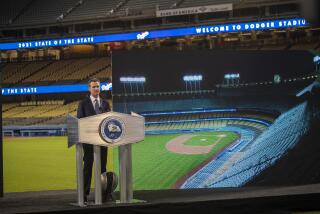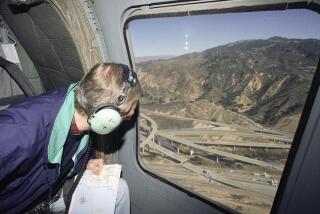Wilson Invites ‘Composites’ to Capital for a Real Lunch
SACRAMENTO — Real food for real people.
The three Californians who had lunch with Gov. Pete Wilson on Sunday were men that the governor’s staff had described as “composites” who did not exist but whom the governor had used in a major speech to show that he understood how residents are suffering during the recession.
Wilson on Sunday took responsibility for his staff’s erroneous admission that he invented “composites” of the three men for his speech.
And to prove that they really exist, Wilson lunched with the businessman, former farm worker and construction crew hand whose plights inspired him to write the disputed passage in his Jan. 8 State of the State speech, he said.
“There was a massive failure of communication internally,” Wilson told reporters after the lunch. “It’s my shop. I take responsibility for it.”
Wilson acknowledged that his staff’s statements had put his integrity at risk and said that was why he used campaign funds to pay for Wes Seastrom of La Canada Flintridge, Concepcion Meza of Visalia and Shad Murphy of Ukiah to travel to the Capitol for lunch and a meeting with the press on Sunday.
“We were asked for evidence,” Wilson said dryly, as he presented the trio.
Indeed, Seastrom seemed to match Wilson’s description of a gray-haired businessman whose eyes grew moist as he told the governor of the anguish he felt laying off workers at his Glendale machine shop. Wilson toured Seastrom’s company on Dec. 9.
And Meza, now a janitor in a state office building, was the farm worker “idled by a killer arctic freeze” who met with Wilson and his wife, Gayle, last March.
But Murphy was another story.
In his speech, Wilson said he had “seen the kindly face of a carpenter who, because he could find no work framing houses, now makes children’s toys for free.”
To be sure, the 20-year-old California Conservation Corps worker is learning carpentry now in the state’s youth training program. And he did take part in a weekend volunteer project to craft wooden toys for needy children, which Wilson presented in a ceremony in December.
But Murphy never framed houses and never was thrown out of work in the construction trades. After dropping out of college, he joined the CCC, where he works full time at near-minimum wage plus room and board. He made the toys in his spare time because he has a soft spot for kids, not to while away idle days, as the governor implied.
Murphy stole the show Sunday, showing up for his second meeting with the buttoned-down governor wearing blue denim shorts, a T-shirt, and white socks under his leather sandals. His mop of curly hair was pulled back into a ponytail.
The former Yucca Valley resident spurned Wilson’s offer of a club sandwich and instead asked for something without meat, which the governor’s caterer provided: a sandwich of cucumber, tomato and squash. “Your basic vegetarian,” Murphy said.
Asked by reporters if he thought the governor’s reference to an out-of-work carpenter could have been him, Murphy replied: “Realistically, no.”
He said he was so underwhelmed by the controversy that he was “tempted not to come.” But he said he “kind of felt like I had to” make the 3 1/2-hour trip because he might have misled Wilson in their brief conversation on Dec. 20 by discussing his CCC carpentry work.
He described the tempest as “something over nothing.”
But the Republican governor said he took any allegation of a “fabrication” seriously.
“There hasn’t been (a fabrication),” he said. “I want people to understand that.”
The dispute began when a San Jose Mercury News reporter asked Wilson’s press office for the identity of the carpenter that the governor mentioned in his speech. The aide asked Wilson, and the governor said he did not have a name, but the reference was to one of several young men who had attended the event in his office.
After a week of searching, the press office could not find Murphy, and concluded that the governor had pieced together not only the carpenter but the businessman and the farm worker from all those he had met in his travels around the state.
“There is no carpenter,” Deputy Press Secretary Franz Wisner told the Mercury News. “That first part of the speech is a composite of the thousands of Californians the governor has come in contact with.”
That admission and statements by Press Secretary Bill Livingstone that the three were “allegories” meant to symbolize the pain in California set off a flurry of criticism of Wilson for concocting tales of suffering.
Democratic Senate President Pro Tem David A. Roberti (D-Los Angeles) said the incident showed that Wilson was out of touch and added: “A 30-second walk into the downtown of any city in California would have produced far more real examples than the contrivances.”
Trying to smother the story on Friday, the press office only made it worse, claiming that the people were real and composites at the same time.
Wilson finally stepped in, and by Friday night had dashed off letters to Seastrom, Meza and Murphy, which, while apologizing for thrusting them into the limelight, were meant to show that they were indeed real people.
Wilson said Sunday he could not explain the discrepancy in his description of Murphy as an unemployed home builder. “The framing of houses is something said to me, and I can’t tell you by whom,” Wilson said. “I was under a false impression.”
He also could not explain why his staff had created the impression that he had made up the stories. “What is really true is that we were trying to portray through representative stories the people who have in fact experienced suffering,” Wilson said. “As it turns out, they are real. I knew that then. But many people did not.
“They were not concocted. . . . They are not allegorical. . . . They are not composites. They are representative.”
Wilson would not say whether he had taken any aides “to the woodshed,” but did concede that he had not spent enough “quality time” with his press spokesmen lately.
“I am, among other things, going to explain to them the difference between allegorical and representative,” he said.
Times staff writer Carl Ingram contributed to this report.
More to Read
Get the L.A. Times Politics newsletter
Deeply reported insights into legislation, politics and policy from Sacramento, Washington and beyond. In your inbox three times per week.
You may occasionally receive promotional content from the Los Angeles Times.










